Biocentrism: How Life and Consciousness Are the Keys to Understanding the True Nature of the Universe (10 page)
Authors: MD,;Bob Berman Robert Lanza

BOOK: Biocentrism: How Life and Consciousness Are the Keys to Understanding the True Nature of the Universe
4.2Mb size Format: txt, pdf, ePub
So now let’s use a device that shoots off entangled twins in different directions. Experimenters can create the entangled photons by using a special crystal called beta-barium borate (BBO). Inside the crystal, an energetic violet photon from a laser is converted to two red photons, each with half the energy (twice the wavelength) of the original, so there’s no net gain or loss of energy. The two outbound entangled photons are sent off in different directions. We’ll call their path directions
p
and
s
.
p
and
s
.
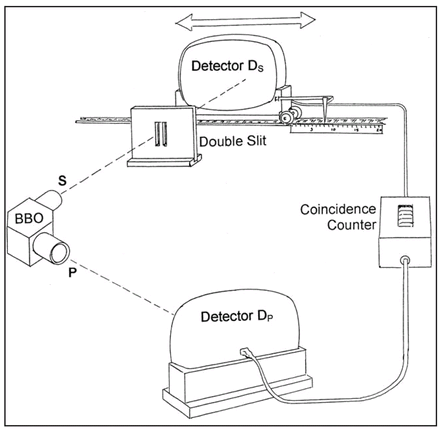
We’ll set up our original experiment with no which-way information measured. Except that now we add a “coincidence counter.” The role of the coincidence counter is to prevent us from learning the polarity of the photons at detector
S
unless a photon also hits detector
P
. One twin goes through the slits (call this photon
s
) while the other merely barrels ahead to a second detector. Only when both detectors register hits at about the same time do we know that both twins have completed their journeys. Only then does something register on our equipment. The resulting pattern at detector
S
is our familiar interference pattern:
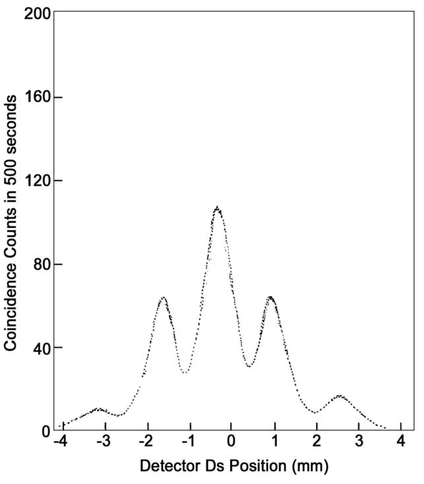
S
unless a photon also hits detector
P
. One twin goes through the slits (call this photon
s
) while the other merely barrels ahead to a second detector. Only when both detectors register hits at about the same time do we know that both twins have completed their journeys. Only then does something register on our equipment. The resulting pattern at detector
S
is our familiar interference pattern:

This makes sense. We haven’t learned which slit any particular photon or electron has taken, so the objects have remained probability waves.
But let’s now get tricky. First, we’ll restore those QWPs so we can get which-way information for photons traveling along path
S
.
S
.
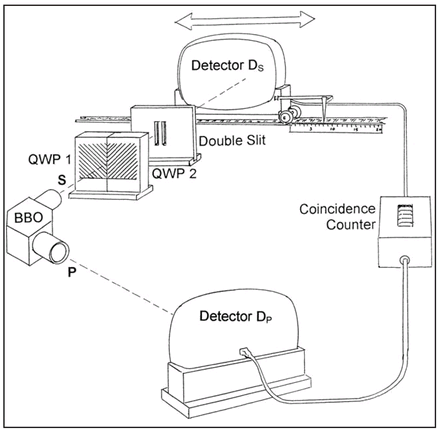
As expected, the interference pattern now vanishes, replaced with the particle pattern, the single curve.
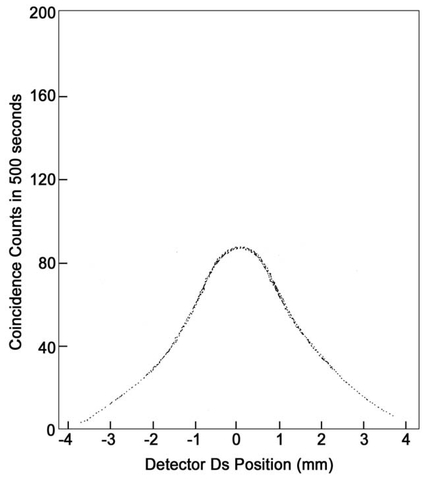
So far, so good. But now, let’s destroy our ability to measure the which-way paths of the
s
photons
but without interfering with them in any way
. We can do this by placing a polarizing window in the path of the other photon
P
, far away. This plate will stop the second detector from registering coincidences. It’ll measure only some of the photons, and effectively scramble up the double-signals. Because a coincidence counter is essential here in delivering information about the completion of the twins’ journeys, it has now been rendered thoroughly unreliable. The entire apparatus will now be uselessly unable to let us learn which slit individual photons take when they
travel along path
S
because we won’t be able to compare them with their twins—because nothing registers unless the coincidence counter allows it to do so. And let’s be clear: we’ve left the QWPs in place for photon
S
. All we’ve done is to meddle with the
p
photon’s path in a way that removes our ability to use the coincidence counter to gain which-way knowledge. (The setup, to review, delivers information to us, registers “hits” only when polarity is measured at detector
S and
the coincidence counter tells us that either a matching or non-matching polarity has been simultaneously registered by the twin photon at detector
P.
) The result:
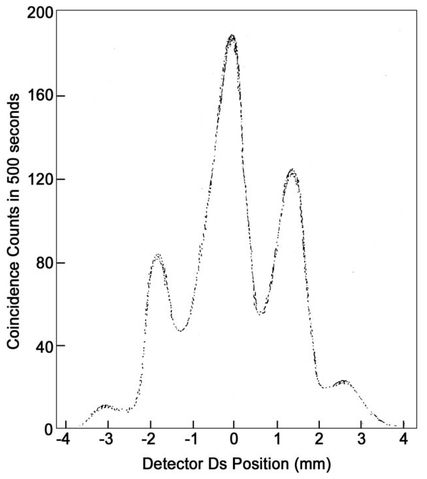
s
photons
but without interfering with them in any way
. We can do this by placing a polarizing window in the path of the other photon
P
, far away. This plate will stop the second detector from registering coincidences. It’ll measure only some of the photons, and effectively scramble up the double-signals. Because a coincidence counter is essential here in delivering information about the completion of the twins’ journeys, it has now been rendered thoroughly unreliable. The entire apparatus will now be uselessly unable to let us learn which slit individual photons take when they
travel along path
S
because we won’t be able to compare them with their twins—because nothing registers unless the coincidence counter allows it to do so. And let’s be clear: we’ve left the QWPs in place for photon
S
. All we’ve done is to meddle with the
p
photon’s path in a way that removes our ability to use the coincidence counter to gain which-way knowledge. (The setup, to review, delivers information to us, registers “hits” only when polarity is measured at detector
S and
the coincidence counter tells us that either a matching or non-matching polarity has been simultaneously registered by the twin photon at detector
P.
) The result:

They’re waves again. The interference pattern is back. The physical places on the back screen where the photons or electrons taking path
s
struck have now changed. Yet
we
did nothing to
these
photons’ paths, from their creation at the crystal all the way to the final detector. We even left the QWPs in place. All we did was meddle with the twin photon far away so that it destroyed our ability to learn information. The only change was in our minds. How could photons taking path
S
possibly know that we put that other polarizer in place—somewhere else, far from their own paths? And quantum theory tells us that we’d get this same result even if we placed the information-ruiner at the other end of the universe.
s
struck have now changed. Yet
we
did nothing to
these
photons’ paths, from their creation at the crystal all the way to the final detector. We even left the QWPs in place. All we did was meddle with the twin photon far away so that it destroyed our ability to learn information. The only change was in our minds. How could photons taking path
S
possibly know that we put that other polarizer in place—somewhere else, far from their own paths? And quantum theory tells us that we’d get this same result even if we placed the information-ruiner at the other end of the universe.
(Also, by the way, this proves that it wasn’t those QWP plates that were causing the photons to change from waves to particles, and to alter the impact points on the detector. We now get an interference pattern even with the QWPs in place. It’s our knowledge alone with which the photons or electrons seem concerned. This alone influences their actions.)
Okay, this is bizarre. Yet these results happen every time, without fail. They’re telling us that an observer determines physical behavior of “external” objects.
Could it
get
any weirder? Hold on: now we’ll try something even more radical—an experiment first performed only in 2002. Thus far, the experiment involved erasing the which-way information by meddling with the path of
p
and
then
measuring its twin
s
. Perhaps some sort of communication takes place between photon
p
and s, letting
s
know what we will learn, and therefore giving it the green light to be a particle or a wave and either create or not create an interference pattern. Maybe when photon
p
meets the polarizer it sends
s
an IM (instant message) at infinite speed, so that photon
s
knows it must materialize into a real entity instantly, which has to be a particle because only particles can go through one slit or the other and not both. Result: no interference pattern.
get
any weirder? Hold on: now we’ll try something even more radical—an experiment first performed only in 2002. Thus far, the experiment involved erasing the which-way information by meddling with the path of
p
and
then
measuring its twin
s
. Perhaps some sort of communication takes place between photon
p
and s, letting
s
know what we will learn, and therefore giving it the green light to be a particle or a wave and either create or not create an interference pattern. Maybe when photon
p
meets the polarizer it sends
s
an IM (instant message) at infinite speed, so that photon
s
knows it must materialize into a real entity instantly, which has to be a particle because only particles can go through one slit or the other and not both. Result: no interference pattern.
To check out whether this is so, we’ll do one more thing. First, we’ll stretch out the distance
p
photons have to take until they reach their detector, so it’ll take them more time to get there. This way,
photons taking the
S
route will strike their own detectors first. But oddly enough, the results do not change! When we insert the QWPs to path
S
the fringes are gone, and when we insert the polarizing scrambler to path
P
and lose the coincidence-measuring ability that lets us determine which-way information for the
S
photons, the fringes return as before. But how can this be? Photons taking the
S
path already finished their journeys. They either went through one or the other slit or both. They either collapsed their “wave-function” and became a particle or they didn’t. The game’s over, the action’s finished. They’ve each already hit the final barrier and were detected—
before
twin
p
encountered the polarizing scrambling device that would rob us of which-way information.
p
photons have to take until they reach their detector, so it’ll take them more time to get there. This way,
photons taking the
S
route will strike their own detectors first. But oddly enough, the results do not change! When we insert the QWPs to path
S
the fringes are gone, and when we insert the polarizing scrambler to path
P
and lose the coincidence-measuring ability that lets us determine which-way information for the
S
photons, the fringes return as before. But how can this be? Photons taking the
S
path already finished their journeys. They either went through one or the other slit or both. They either collapsed their “wave-function” and became a particle or they didn’t. The game’s over, the action’s finished. They’ve each already hit the final barrier and were detected—
before
twin
p
encountered the polarizing scrambling device that would rob us of which-way information.
The photons somehow know whether or not we will gain the which-way information
in the future
. They decide not to collapse into particles before their distant twins even encounter our scrambler. (If we take away the
P
scrambler, the
S
photons suddenly revert to being particles, again before
P
’s photons reach their detector and activate the coincidence counter.) Somehow, photon
s
knows whether the which-way marker will be erased even though neither it, nor its twin, have yet encountered an erasing mechanism. It knows when its interference behavior can be present, when it can safely remain in its fuzzy both-slits ghost reality, because it apparently knows photon
p
—far off in the distance—is going to hit the scrambler
eventually
, and that this will ultimately prevent us from learning which way
p
went.
in the future
. They decide not to collapse into particles before their distant twins even encounter our scrambler. (If we take away the
P
scrambler, the
S
photons suddenly revert to being particles, again before
P
’s photons reach their detector and activate the coincidence counter.) Somehow, photon
s
knows whether the which-way marker will be erased even though neither it, nor its twin, have yet encountered an erasing mechanism. It knows when its interference behavior can be present, when it can safely remain in its fuzzy both-slits ghost reality, because it apparently knows photon
p
—far off in the distance—is going to hit the scrambler
eventually
, and that this will ultimately prevent us from learning which way
p
went.
It doesn’t matter how we set up the experiment. Our mind and its knowledge or lack of it is
the only thing
that determines how these bits of light or matter behave.
the only thing
that determines how these bits of light or matter behave.
It forces us, too, to wonder about space and time. Can either be real if the twins act on information before it happens, and across distances instantaneously as if there is no separation between them?
Again and again, observations have consistently confirmed the observer-dependent effects of quantum theory. In the past decade, physicists at the National Institute of Standards and Technology have carried out an experiment that, in the quantum world, is equivalent
to demonstrating that a watched pot doesn’t boil. “It seems,” said Peter Coveney, a researcher there, “that the act of looking at an atom prevents it from changing.” (Theoretically, if a nuclear bomb were watched intently enough, it would not explode, that is, if you could keep checking its atoms every million trillionth of a second. This is yet another experiment that supports the theory that the structure of the physical world, and of small units of matter and energy in particular, are influenced by human observation.)
to demonstrating that a watched pot doesn’t boil. “It seems,” said Peter Coveney, a researcher there, “that the act of looking at an atom prevents it from changing.” (Theoretically, if a nuclear bomb were watched intently enough, it would not explode, that is, if you could keep checking its atoms every million trillionth of a second. This is yet another experiment that supports the theory that the structure of the physical world, and of small units of matter and energy in particular, are influenced by human observation.)
In the last couple of decades, quantum theorists have shown, in principle, that an atom cannot change its energy state as long as it is being continuously observed. So, now, to test this concept, the group of laser experimentalists at NIST held a cluster of positively charged beryllium ions, the
water
so to speak, in a fixed position using a magnetic field, the
kettle
. They applied
heat
to the kettle in the form of a radio-frequency field that would boost the atoms from a lower to a higher energy state. This transition generally takes about a quarter of a second. However, when the researchers kept checking the atoms every four milliseconds with a brief pulse of light from a laser, the atoms never made it to the higher energy state, despite the force driving them toward it. It would seem that the process of measurement gives the atoms “a little nudge,” forcing them back down to the lower energy state—in effect, resetting the system to zero. This behavior has no analog in the classical world of everyday sense awareness and is apparently a function of observation.
water
so to speak, in a fixed position using a magnetic field, the
kettle
. They applied
heat
to the kettle in the form of a radio-frequency field that would boost the atoms from a lower to a higher energy state. This transition generally takes about a quarter of a second. However, when the researchers kept checking the atoms every four milliseconds with a brief pulse of light from a laser, the atoms never made it to the higher energy state, despite the force driving them toward it. It would seem that the process of measurement gives the atoms “a little nudge,” forcing them back down to the lower energy state—in effect, resetting the system to zero. This behavior has no analog in the classical world of everyday sense awareness and is apparently a function of observation.
Other books
Everything But Perfect by Willow, Jevenna
The One Girl by Laurel Curtis
Escapology by Ren Warom
Vanish in an Instant by Margaret Millar
Seduction's Shift by A.C. Arthur
Blackwing Defender (Kane's Mountains Book 1) by T. S. Joyce
Freeze Tag by Cooney, Caroline B.
Pirate Island Treasure by Marilyn Helmer
1963 - One Bright Summer Morning by James Hadley Chase
The Kill Zone by David Hagberg
